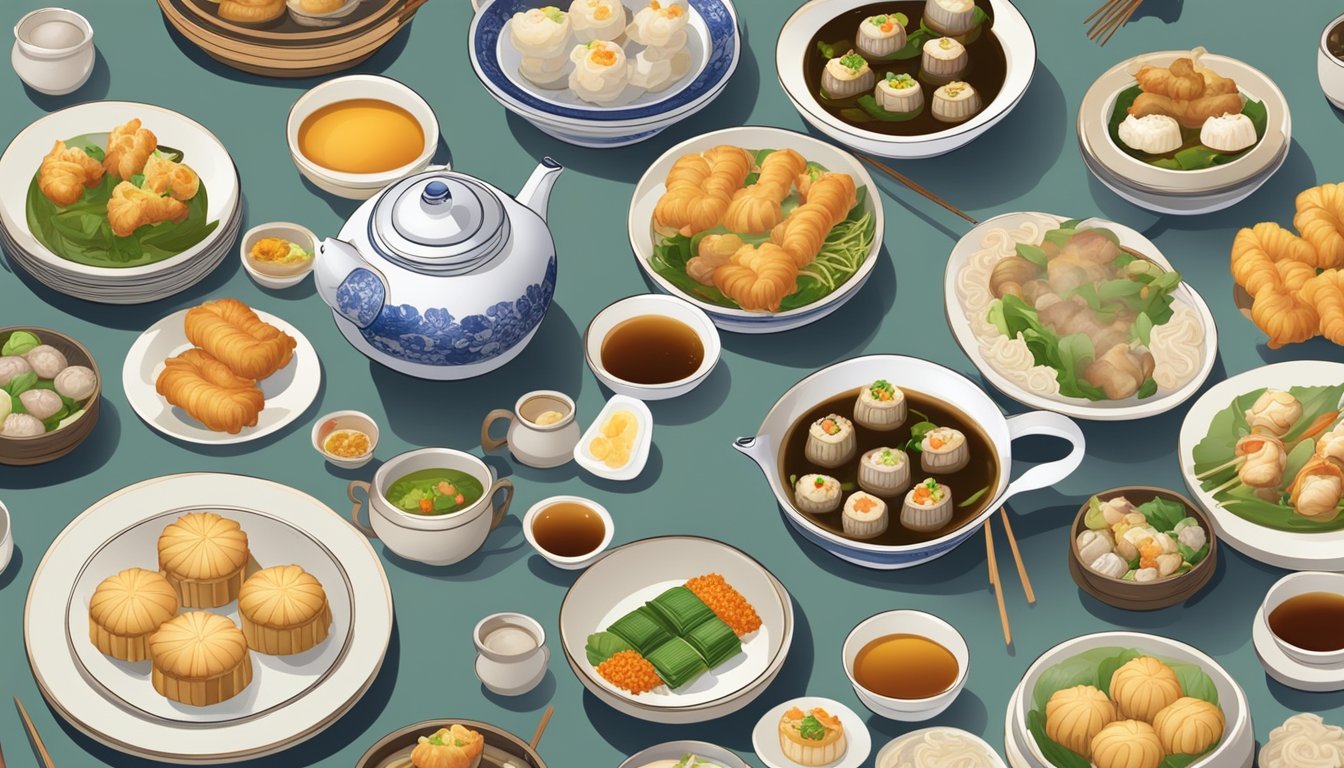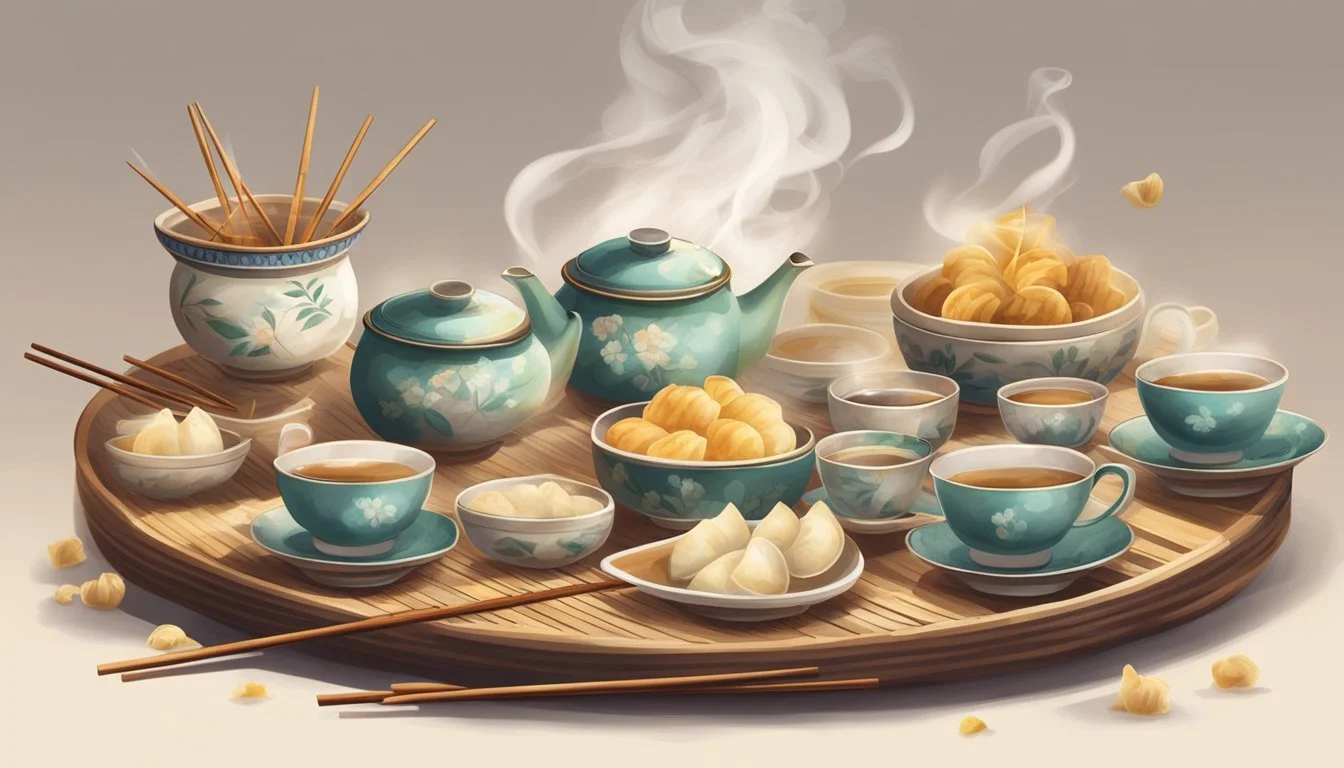How Do You Eat Dim Sum?
Your Ultimate Guide to Enjoying This Culinary Tradition
Dim sum is a traditional Cantonese dining experience that has become synonymous with Chinese cuisine around the world, particularly in regions like Hong Kong, Guangzhou, and in broader communities tracing their heritage to Southern China. This culinary practice, deeply rooted in Cantonese dim sum culture, is not just a meal but a social event often shared among family and friends. Typically enjoyed during brunch (What wine goes well with brunch?) hours, dim sum includes an array of small, bite-sized dishes, meant to be ordered and savored communally. The term 'yum cha,' which translates to 'drink tea,' goes hand in hand with dim sum as enjoying tea is an integral part of the experience.
The variety of dishes served during a dim sum meal can range from steamed buns and dumplings to rice noodle rolls and tarts. Each dish is crafted to offer a burst of flavor and texture, often showcasing both traditional and inventive fillings. Restaurants specializing in dim sum typically present these dishes to diners via pushcarts, allowing for an interactive selection process where guests can visually inspect and choose their preferred dishes as the carts pass by. Alternatively, some establishments provide menus or checklist cards to mark selections which are then prepared fresh and delivered to the table.
In the tradition of dim sum, every detail is considered, from the choice of tea to complement the meal to the etiquette of using chopsticks and sharing amongst the table. These customs foster a vibrant and engaging dining atmosphere, encouraging conversation and connection while indulgentsample the array of savory and sweet offerings. The practice of sharing dim sum is emblematic of broader cultural values that emphasize gathering, sharing, and hospitality, making it a rich, communal dining experience that extends beyond the food itself.
Understanding Dim Sum
Dim sum is an integral part of Chinese culinary tradition, typically consisting of a variety of small dishes meant to be shared and enjoyed with tea. Originating from Cantonese culture, this meal reflects a rich history and significant cultural traditions.
Historical Background
Dim sum has its roots deeply embedded in the history of southern China, particularly Guangdong Province, with its tradition stretching back to the 19th century. Teahouses along the Silk Road began serving these small bites to weary travelers and locals looking for a relaxing venue to discuss business and socialize. The name "dim sum" itself translates to "touch the heart," an apt descriptor for the way these dishes were intended to delight the senses without overwhelming the appetite.
Cultural Significance
Culturally, dim sum plays a notable role in Cantonese dim sum culture, often associated with the concept of 'yum cha,' or "drinking tea." Tea houses in cities like Guangzhou and Hong Kong became social hubs where families and friends would gather to savor dim sum dishes as they engaged in lively conversation. Traditionally enjoyed during brunch hours, dim sum is synonymous with Chinese New Year celebrations and other festivals. The act of sharing these dishes is reflective of the family-style dining that is central to Chinese hospitality and etiquette. Moreover, it's a culinary practice that exemplifies the community-based ethos of Cantonese culture, with a myriad of choices allowing for an inclusive dining experience.
Preparing for Dim Sum
Dim sum is a traditional Chinese cuisine that offers a variety of small plates usually enjoyed in a communal dining setting with tea, embodying the cultural essence of Guangzhou and Hong Kong. It’s an experience that's as much about the food as it is the atmosphere and social aspect.
Choosing the Right Venue
When selecting a venue for dim sum, a crucial decision lies in determining the type of experience desired. Patrons might opt for traditional tea houses where the atmosphere is often lively and social, or higher-end establishments where the setting might be more formal. A well-chosen venue will resonate with the essence of Cantonese culture, providing not only a meal but a distinct dining ambiance.
Traditional Tea Houses: Ideal for a casual, authentic experience.
Upscale Restaurants: Suited for those looking for a more refined experience.
Understanding the Menu
A typical dim sum menu includes a wide array of Chinese delicacies such as steamed buns, dumplings, pastries, and desserts. For those unfamiliar with the options, it’s important to understand that dim sum dishes are meant to be shared. Selections are often in the form of small plates or baskets, designed to be ordered in multiples so that everyone at the table can partake in the variety.
Steamed Buns: Baozi containing a range of fillings.
Dumplings: Har gow (shrimp dumplings) and siu mai (shrimp and pork dumplings (What Wine Pairs Best with Pork Dumplings)).
Pastries: Sweet or savory, often baked or fried.
Desserts: Sweet confections, often concluding the meal.
Seating and Etiquette
Upon being seated, the first order of business is choosing a tea. Tea is central to the dim sum experience, facilitating the digestion of the rich variety of foods that will follow. Choosing the right tea to accommodate the tastes of everyone at the table is part of the communal nature of the meal.
Etiquette at a dim sum restaurant ensures a pleasant dining experience for all. It includes polite behavior, proper use of utensils and chopsticks, and a respect for the shared dining atmosphere. Seating is often arranged to accommodate group dining, encouraging sharing amongst family and friends.
Tea: Integral part of the meal, selected first.
Utensils: Proper use of chopsticks and serving utensils is expected.
Sharing: Dishes are communal and meant for everyone to enjoy.
Navigating the Dim Sum Experience
Dim sum offers a unique dining experience combining diverse flavors and communal eating. It requires strategic ordering and a willingness to explore a variety of dishes.
Ordering Process
In traditional dim sum restaurants, diners select from an assortment of dishes presented on carts pushed by servers throughout the dining area. The process begins with choosing a tea, which is intrinsic to the dim sum experience. After tea selection, groups typically order small plates from a menu or directly from the circulating carts. Each dish is intended for sharing, and items are often marked off on the table's order card as they are chosen.
Types of Dim Sum
Dim sum dishes cover an extensive range of cooking styles: steamed, fried, baked, and deep-fried. Choices range from tender dumplings to hearty buns, covering all flavor profiles from sweet to savory. Typical ingredients include shrimp, pork, chicken, and a variety of vegetables, prepared in bite-sized portions conducive to group dining.
Popular Dim Sum Dishes
Some popular dim sum items to consider include:
Shrimp Dumplings (Har Gow): A classic steamed dumpling with a delicate wheat starch skin.
Siu Mai: Open-faced steamed pork and shrimp dumplings often topped with a hint of roe.
Char Siu Bao: Fluffy, baked buns filled with sweet barbecued pork.
Egg Tarts: Sweet, baked tartlets with a custardy filling for those craving dessert.
Rice Noodle Rolls (Cheong Fun): Steamed rice sheets rolled around various fillings such as shrimp or beef.
Chicken Feet: Deep-fried and then steamed, and seasoned with a rich, flavorful sauce.
Encounters with dim sum are both convivial and culinary, inviting diners to sample and share a plethora of dishes ranging from the familiar to the adventurous.
Dim Sum Dining Tips
In the tradition of dim sum or 'yum cha', understanding the tea rituals, dining etiquette, and bill handling are fundamental to an authentic and enjoyable meal experience.
Tea Selection and Rituals
When seated at a tea house for dim sum, the first course of action is to select a tea for the table. The choice of tea is an integral part of the meal, with different types such as jasmine or pu-erh catering to various preferences. Tea etiquette is central, and it is customary to serve others before oneself. The ritual of pouring tea for each other fosters a sense of communal dining and respect among diners.
Eating Etiquette
Dim sum is traditionally shared, so when ordering, it is important to choose a variety of small dishes for everyone at the table to enjoy. Chopsticks and spoons are the primary utensils and one should use them appropriately—chopsticks to pick up items like dumplings, and spoons for soups and other liquid-containing offerings. Part of the shared experience includes passing dishes, making use of serving utensils, and not laying claim to any one dish, as everything is meant for all to sample.
Handling the Bill
At the end of a dim sum meal, payment is typically processed in one of two ways: a card that is stamped or marked with each dish ordered or a bill that is tallied at the end of the meal. Often in group dining situations, one person may handle the entire bill. However, it's also common for the bill to be split evenly between guests. In any case, leaving tips for the service staff is customary and appreciated.
Specialty Dishes and Regional Variations
Dim sum boasts an array of specialty dishes that vary by region, reflecting the richness of Chinese cuisine. With Cantonese roots, it offers a tapestry of flavors ranging from traditional staples to contemporary, fusion-inspired creations.
Cantonese Classics
Cantonese dim sum originates from the heart of Guangdong Province, formerly known as Canton, and is thought to have reached its greatest refinement in Hong Kong. Central to the experience are Har Gow, delicate shrimp dumplings with a translucent wrapper, and Shao Mai, open-topped dumplings typically filled with pork and shrimp. The Char Siu Bao, or barbecue pork buns, serve as a savory, sweet staple, with tender pork encased in fluffy dough. Vegetables play a significant role, often sautéed and served with oyster sauce or utilized as wrappers, like in the case of Lo Mai Gai—glutinous rice stuffed with chicken and wrapped in a lotus leaf.
Har Gow: Shrimp dumplings with a wheat starch wrapper
Shao Mai: Dumplings with pork and shrimp filling
Char Siu Bao: Barbecue pork-filled buns
Lo Mai Gai: Glutinous rice with chicken in lotus leaf
Innovative and Fusion Offerings
The innovation in dim sum reflects the adaptability of Chinese cuisine, meshing traditional techniques with global influences. Chefs may incorporate ingredients like truffle oil into Shao Mai, or present entirely new creations that diverge from Cantonese origins. Egg rolls and spring rolls can be found with unconventional fillings, pushing beyond the expected tastes. Even classic Cantonese Egg Tarts are reimagined to suit contemporary palates, possibly infused with new flavors or paired with novel textures. These innovations reflect the dynamism of regional Chinese dishes as they evolve in an increasingly globalized culinary landscape.
After the Meal
Once the dim sum experience is complete, patrons often extend the cultural enrichment by engaging in socializing or exploring nearby attractions.
Socializing and Networking
After enjoying a meal of dim sum, it is common for guests to partake in extended conversations over the remaining tea. Tea houses are not just culinary outlets but also social hubs where family and friends reinforce bonds, and business acquaintances engage in networking. This tradition, known as "yum cha," which translates to 'drink tea', promotes a sense of community and friendship, encouraging people to relax and interact after their meal.
Exploring Nearby Attractions
Frequently located in culturally rich areas, many dim sum venues are situated conveniently close to local attractions. Guests can choose to take a leisurely walk to digest their meal, a practice that benefits both health and social enjoyment. Exploring local markets, parks, or historical sites allows for the continuation of a cultural experience. Whether it's a family outing or a touristic adventure, visiting local attractions complements the culinary journey of a dim sum brunch.





